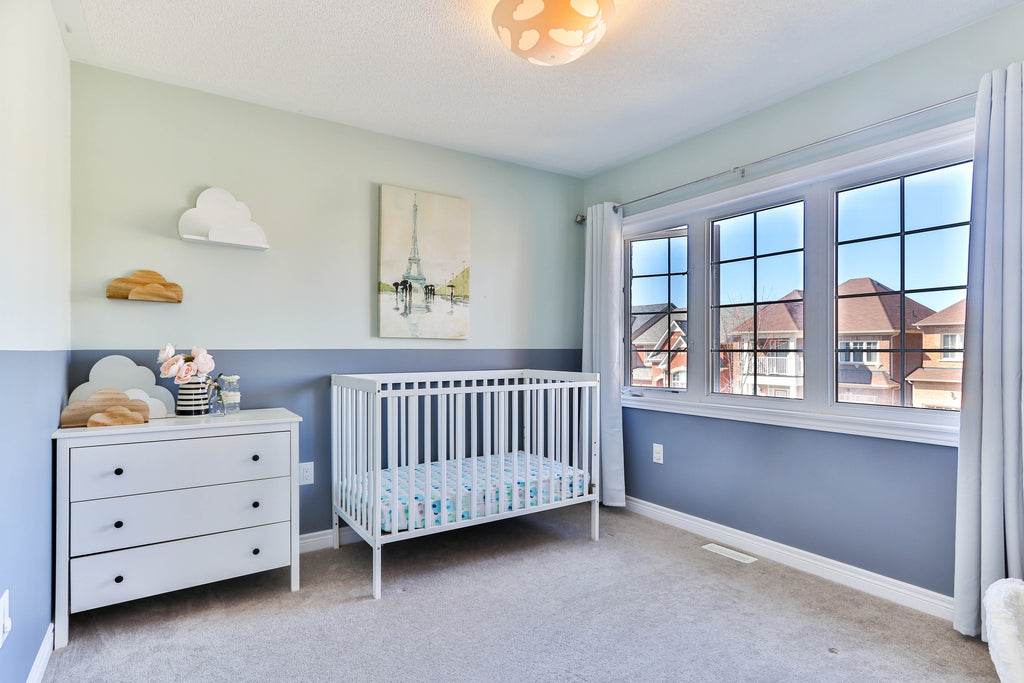
Creating A Healthy Nursery: The Basics
Why is this important?
- Babies have developing immune systems that are more vulnerable to the negative impacts of poor indoor air quality.
- Babies breathe at a faster rate than adults, with an increased intake of toxins in relation to their body weight.
- The “breathing zone” for children, and babies in particular, is closer to the ground where pollutants are more concentrated.
- Children’s frequent hand-to-mouth activity increases their risk of toxic intake.
- Infants’ bodies are not as able to detoxify and excrete toxins as easily as adults’.
Indoor Air Quality can be negatively affected by many things including the off-gassing from various materials and surfaces found in the home (i.e. paints, carpets, mattresses, bedding, furniture, and even cleaning products). Using the most natural and organic materials will not only enhance the indoor air quality, but will give babies’ immune systems the best opportunity to adapt to their new environment.
Coatings & Finishes:
- Use Low and Zero VOC (volatile organic compound) paints, stains and finishes on walls, flooring, furniture, etc.
- Purchase non-toxic products that seal in off-gassing from previously finished surfaces.
Flooring - Consider:
- 99% all natural, non-toxic wool carpet – no dyes, treatments or moth proofing.
- All natural fiber area rugs in many colors, custom designs and styles (e.g. hooked, woven, hand tied and hand-dyed).
- Anti-microbial and all natural linoleum and cork.
- Unfinished reclaimed woods.
Mattresses:
Traditional crib mattresses are made from synthetic, petroleum based products and are sprayed with toxic flame retardants. Natural latex rubber or innerspring crib mattresses covered by wool (naturally flame retardant and resistant to dust mites) and organic cotton are both much healthier alternatives for your baby.
Cribs & Bassinettes:
Look for furniture made from solid wood (instead of pressed or particle board) and finished using water-based or natural plant oil finishes. They are safer for babies that are teething or in contact with the frame. Furniture made with pressed or particle board and finished with stains, lacquers and urethanes can off-gas formaldehyde and other VOC’s into the air.
Natural and Organic Bedding/Clothing:
Purchasing organic and natural fibers (i.e. organic cotton, bamboo, hemp, etc.) keeps harmful dyes, pesticides and other chemicals from reaching your babies’ sensitive skin.
Air Purifiers:
A dedicated single room air purifier is a good idea for the nursery. Look for those with HEPA, anti-microbial, UV and/or ionization filters built in.
Cleaning Products:
Use all natural, biodegradable, non-toxic, hypoallergenic clean-ing products and tools. Especially laundry detergents, dish and floor cleaners. Avoid ammonia, bleach, phosphates, nitrates, borates and triclosan. Or make your own household cleaners. Distilled white vinegar, baking soda, lemon juice still work wonders.
Bottles, Toys, and Accessories:
Research shows that Bisphenol-A (a hormone disrupting chemical) and phthalates (found in many “soft” plastics) can leach into liquids and are harmful for you and your baby. The best options are glass bottles or plastic bottles made from polypropylene (#5) and using silicone nipples. Be wary of plastic toys, especially teethers. Look for natural latex rubber or wooden toys that, again, are finished with water-based or natural plant oil products. Organic cotton dolls and natural, unbleached fabrics are much safer alternatives when your new child needs something to put in its mouth.
Here are a few FREE suggestions to create a healthier home.
1. Take off your shoes at the door (and ask guests to do the same)! Pollutants are tracked in on the bottoms of our shoes. Your new baby will spend a lot of time on the floor and will greatly benefit from reduced toxins being tracked into the home.
2. Wash all synthetic bedding and clothing in a non-toxic, plant-based, biodegradable laundry detergent to help remove some of the chemical residue.
3. Vacuum carpet often. Look for vacuums that have a HEPA filter installed.
4. Open windows and allow fresh air to circulate throughout the home.
5. Trust your instincts. Read labels. Follow your nose. If something has lots of ingredients you don’t recognize or can’t pronounce or has an obvious synthetic aroma… avoid it.

